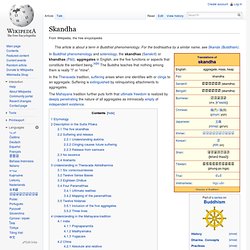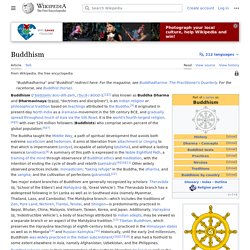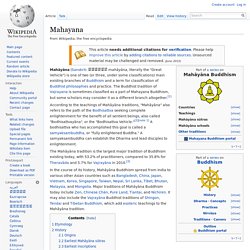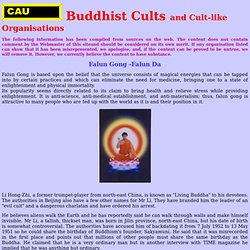

The Three Vehicles: Hinayana, Mahayana and Tantrayana. "The difference between the wise Buddhist and the sectarian Buddhist is like that between the vastness of space and the narrowness of a vase.

" Kongtrul Rinpoche. Bodhisattva. Nibbana. Buddhism. In this section are descriptions of Budhism and belifs and topics related to its practice.

(Some of the subjects fit into other Topics also.) Buddhism Anatta (anatman) Anicca Atman Bhutatathata Bodhisattva Buddhi Cetasika Cintamani Circumambulation Cosmology, Buddhism Deva-duta Dhamma-cakka Dhamma-cakkapavattana-sutta Dukkha Karma Khandha Manas Mantra Moksa Nibbana Pali Prajna Prakrti Prayer Wheel Rupa Sankhara Skandhas Storehouse consciousness Tattva Three Marks of Existence Vijana. Buddhism. Back to Home Page or Contents Page or Religions and Sects or Index Buddhism When teaching the Buddha regarded himself as a guide and physician, diagnosing ailments and pointing out the path to recovery.

As presented now in texts, he taught in the basic components of Hindu cosmology and psychology (long cycles of time, and equally periods through which a self or soul, atman, is reborn as it moves, controlled by karma as cause, toward freedom or salvation, moksa), but modified them drastically: he saw all appearance as characterized by dukkha (transience, anicca, accompanied by suffering that arises if one seeks something permanent or eternal in its midst). It follows that there cannot be a soul, but only the sequence of one moment giving rise to the next, constituting appearances with characteristic possibilities (human, for example, as oppose to animal, through the skandhas, aggregations).
The no-soul doctrine is referred to as anatman. Suffering is the central fact in living. Sources: Ratnasambhava. Ratnasambhava is one of the Five Dhyani Buddhas (or "Five Meditation Buddhas") of Vajrayana or Tantric Buddhism.

Ratnasambhava's mandalas and mantras focus on developing equanimity and equality and, in Vajrayana buddhist thought is associated with the attempt to destroy greed and pride. His consort is Mamaki and his mount is a horse or a pair of lions. Skandha. In the Theravada tradition, suffering arises when one identifies with or clings to an aggregate.

Suffering is extinguished by relinquishing attachments to aggregates. The Mahayana tradition further puts forth that ultimate freedom is realized by deeply penetrating the nature of all aggregates as intrinsically empty of independent existence. Etymology[edit] Outside of Buddhist didactic contexts, "skandha" can mean mass, heap, pile, gathering, bundle or tree trunk.[3][c] According to Thanissaro, the buddha gave a new meaning to the term "khanda": Prior to the Buddha, the Pali word khandha had very ordinary meanings: A khandha could be a pile, a bundle, a heap, a mass. Moksha. In Indian religions and Indian philosophy, moksha (Sanskrit: मोक्ष mokṣa), also called vimoksha, vimukti and mukti,[1] means emancipation, liberation or release.[2] In the soteriological and eschatological sense, it connotes freedom from saṃsāra, the cycle of death and rebirth.

In the epistemological and psychological sense, moksha connotes freedom, self-realization and self-knowledge.[4] In Hindu traditions, moksha is a central concept[5] and included as one of the four aspects and goals of human life; the other three goals are dharma (virtuous, proper, moral life), artha (material prosperity, income security, means of life), and kama (pleasure, sensuality, emotional fulfillment).[6] Together, these four aims of life are called Puruṣārtha in Hinduism.[7] The concept of moksha is found in Jainism, Buddhism and Hinduism. Etymology[edit] Buddhism. Religion founded by the Buddha Buddhism (, ) is an Indian religion based on a series of original teachings attributed to Gautama Buddha.

It originated in ancient India as a Sramana tradition sometime between the 6th and 4th centuries BCE, spreading through much of Asia. It is the world's fourth-largest religion[3] with over 520 million followers, or over 7% of the global population, known as Buddhists.[6] Buddhism encompasses a variety of traditions, beliefs and spiritual practices largely based on the Buddha's teachings (born Siddhārtha Gautama in the 5th or 4th century BCE) and resulting interpreted philosophies. Mahayana. Mahāyāna (Sanskrit: महायान mahāyāna, literally the "Great Vehicle") is one of two (or three, under some classifications) main existing branches of Buddhism and a term for classification of Buddhist philosophies and practice.

The Buddhist tradition of Vajrayana is sometimes classified as a part of Mahayana Buddhism, but some scholars may consider it as a different branch altogether.[1] According to the teachings of Mahāyāna traditions, "Mahāyāna" also refers to the path of the Bodhisattva seeking complete enlightenment for the benefit of all sentient beings, also called "Bodhisattvayāna", or the "Bodhisattva Vehicle. "[2][note 1] A bodhisattva who has accomplished this goal is called a samyaksaṃbuddha, or "fully enlightened Buddha.
" A samyaksaṃbuddha can establish the Dharma and lead disciples to enlightenment. The Mahāyāna tradition is the largest major tradition of Buddhism existing today, with 53.2% of practitioners, compared to 35.8% for Theravāda and 5.7% for Vajrayāna in 2010.[3] Buddhist Cults. Buddhist Cults and Cult-like Organisations The following information has been compiled from sources on the web.

The content does not contain comment by the Webmaster of this siteand should be considered on its own merit. If any organisation listed can show that it has been misrepresented, we apologise, and, if the content can be proved to be untrue, we will remove it. However, we currently believe the content to have substance. Falun Gong -Falun Da Falun Gong is based upon the belief that the universe consists of magical energies that can be tapped into by certain practices and which can eliminate the need for medicine, bringing one to a state of enlightenment and physical immortality. Li Hong-Zhi, a former trumpet-player from north-east China, is known as "Living Buddha" to his devotees. He believes aliens walk the Earth and he has reportedly said he can walk through walls and make himself invisible. Li Honqzhi - Founder of Falun Gonq Falun Dafa: "Our Dharma wheel will protect you..
Religions - Buddhism: Tibetan Buddhism. The New Kadampa Tradition (NKT) Kadampa Buddhism is a special tradition of Mahayana Buddhism founded by Atisha (982-1054 CE), an Indian Buddhist Master largely responsible for the reintroduction of Buddhism into Tibet in the eleventh century. ‘Ka’ refers to all Buddha’s Sutra and Tantra teachings, and ‘dam’ refers to Atisha’s special instructions called the ‘Stages of the Path’, or Lamrim in Tibetan. Kadampa Buddhists integrate their knowledge of all Buddha’s teachings into their everyday lives. AYP Home Page - Free Lessons in Meditation, Pranayama, Kundalini, Tantra. VISHNU, the god of eroticism, dreams about the game of the world. – Vishnu Purana Lakshmi Tantra There are numerous representations of Vishnu. Kelsang Gyatso. Geshe Kelsang Gyatso is a Buddhist monk, "meditation master, scholar, and author"[1] of 22 books based on the teachings of the Gelug school of Tibetan Buddhism.

He is the founder and former spiritual director of the New Kadampa Tradition-International Kadampa Buddhist Union (NKT-IKBU), a Western Buddhist order based primarily on the teachings of the Gelugpa tradition, albeit "not subordinate to Tibetan authorities other than Geshe Gyatso himself. "[2] The NKT-IKBU has grown to become a global Buddhist organisation that currently lists more than 200 centres and around 900 branch classes/study groups in 40 countries.[3] Kelsang Gyatso was born in Tibet in 1931 and ordained at the age of eight. Life and education in Tibet[edit] Dorje Shugden controversy. Dorje Shugden, also known as Dolgyal, was a "gyalpo" "angry and vengeful spirit" of South Tibet, which was subsequently adopted as a "minor protector" of the Gelug school headed by the Dalai Lamas (although nominally the Ganden Tripas).[1][2] Dreyfus says "Shuk-den was nothing but a minor Ge-luk protector before the 1930s when Pa-bong-ka started to promote him aggressively as the main Ge-luk protector.
"[2] Pabongka transformed Dorje Shugden's "marginal practice into a central element of the Ge-luk tradition," thus "replacing the protectors appointed by Dzong-ka-ba himself" and "replacing the traditional supra-mundane protectors of the Ge-luk tradition. "[1] This change is reflected in artwork, since there is "lack of Dorje Shugden art in the Gelug school prior to the end of the 19th century.
Dorje Shugden. Statue of Dorje Shugden Dorje Shugden (Tibetan: རྡོ་རྗེ་ཤུགས་ལྡན, Wylie: rdo-rje shugs-ldan), "Vajra Possessing Strength", or Dolgyal Shugden (Tibetan: དོལ་རྒྱལ་ཤུགས་ལྡན, Wylie: dol rgyal shugs ldan), "Shugden, King of Dhol" is a deity (Tib. lha)[1][2][3] in Tibetan Buddhism, especially its Gelug school, who is regarded as a Dharma Protector or "guardian angel. "[4][5] The practice of Dharma Protectors is central to most religious Tibetans and practitioners of Tibetan Buddhism.[6] Newsweek on "Cult Mystery" Tonpa Shenrab Miwoche. Tonpa Shenrab According to Samten G. Karmey: He occupies a position very similar to that of Śākyamuni in Buddhism, but... we have no available [or pre-10th century] sources with which to establish his historicity, his dates, his racial origin, his activities, and the authenticity of the enormous number of books either attributed directly to him or believed to be his word.
"[1] The story of Tonpa Shenrab Miwoche was revealed in a fourteenth century terma of Loden Nyingpo.[2] Shenrab's life according to Bon traditions[edit]